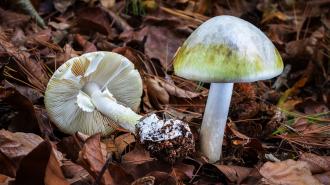The death cap mushroom is an unassuming fungus, lacking the brilliant, colorful warning signs nature often uses to mark toxic creations — its color varies from a greenish hue to a deathly pallor befitting its name.
Unfortunately, it also resembles various delicious mushrooms, and it can kill you, causing the lion’s share of the world’s mushroom poisoning deaths. Within hours of ingestion, vomiting, severe cramps, and diarrhea may develop. These symptoms may clear, only for organ failure — liver and kidneys — to rise up days later.
Despite their fearsome name and toxic reputation, the death cap mushroom has kept the exact mechanism by which it kills a secret.
But by using CRISPR-Cas9 as a screening method, a team led by researchers at China’s Sun Yat-sen University figured out how the death cap’s poison enters human cells — and with that knowledge, a potential future antidote.
Despite their fearsome name and toxic reputation, the death cap mushroom has kept the exact mechanism by which it kills a secret.
What’s inside: We already know that the deadliest component of the death cap mushroom is a toxic peptide called α-amanitin, the researchers wrote in their study, published in Nature Communications.
There’s precious few treatments for α-amanitin poisoning; in addition to supportive care, doctors may give patients a large dose of penicillin G, University of Georgia mycologist Marin Brewer told NPR. “They didn’t know exactly how that worked, but they thought maybe it stimulated the liver.”
A drug candidate derived from milk thistle plants is in the works, Brewer, who was not involved in the research, said. But it is still in FDA trials.
The lack of treatments drew the attention of Sun Yat-sen University drug development researchers Qiaoping Wang and Guohui Wan, who decided to investigate using a method Wang helped develop a few years ago to find an antidote to jellyfish toxin, Nature reports.
To dye for: The team used CRISPR-Cas9 to create a variety of human cells with mutations in different genes. They were then exposed to α-amanitin to see what, if any, mutations helped them to survive.
Cells that escaped their brush with the toxin were missing a working version of an enzyme, STT3B. The enzyme helps add sugar molecules to proteins, Nature reported, and throwing a wrench in this prevents α-amanitin from getting into the cells — limiting the damage.
STT3B had never been connected to death cap mushroom toxicity before, and the team was “totally surprised by our findings,” Wang told Nature.
By using a CRSPR-based screening method, researchers have figured out how the death cap’s toxin enters our cells — and a possible antidote to stop it.
The antidote: Target in hand, the researchers looked for compounds that inhibit STT3B, and they found one: a Kodak-developed dye from the 1950s, called indocyanine green. Used for medical imaging, indocyanine green has long been proven safe and is already FDA-approved.
When tested in mice, the mushroom toxin caused a 90% fatality rate in the control group, but in mice treated with the dye, 50% survived.
The team hopes to begin testing the dye as a death cap mushroom antidote soon, although face a steep challenge: it’ll need to be swiftly administered after someone eats the mushroom.
“If the word antidote is used to mean, like, you give it and everyone recovers, it’s probably not quite there yet, because you haven’t tested it in humans,” Anne Pringle, a University of Wisconsin death cap mushroom expert not involved with the study, told NPR.
“Human trials are tricky when it comes to this kind of work because you can’t feed people mushrooms and then try to cure them.”
We’d love to hear from you! If you have a comment about this article or if you have a tip for a future Freethink story, please email us at [email protected].






